 Visual Agnosia - an overview | ScienceDirect Topics
Visual Agnosia - an overview | ScienceDirect TopicsAssociative AgnosiaRelated terms:T.E. Cope, ... T.D. Griffiths, in , 2015Associative agnosis is more clearly seen in the associative form of the word deafness, where patients are able to discriminate between words but cannot recognize them (Buchtel & Stewart, 1989; Slevc, Martin, 2011 This condition occurs most often in the context of left temporary injuries, but similar injuries can also lead to apceptive deficits (Wang, Peach, Xu, Schneck, & Manry, 2000). Other domains may show a similar dissociation, and a number of patients with foonagnosis (growth agnosia) demonstrated apceptive deficits resulting from temporary lobe injuries in the hemisphere and associative deficits resulting from right parietal lesions (Van Lancker, Kreiman, " Cummings, 1989). However, these observations are difficult to reconcile with the functional image data that suggest a pathway for the identification of voice that is executed before along the right time lobe, without parietal involvement (Belin, Zatorre, Lafaille, Ahad, " Pike, 2000). Michael C. Corballis, in , 19942 AgnosiasAgnosia is the general term of inability, due to brain damage, to recognize previously known objects. At the highest level, then, it can be considered as a "what" system deficit. The recognition of objects can also fail due to the interruption to a previous stage of processing, and we need to distinguish agnosis from the types of deficits mentioned above, which result from visual field defects, or even damage to the prestriated areas of visual cortex; in fact, these lower order deficits are sometimes known as "pseudoagnosias" (Shallice, 1988). Conting with pseudo-agnosias, Lissauer (1890) diluted a distinction between aperceptive agnosia, which is a failure to build an internal representation of an object, and associative agnosia, which is a failure to understand its meaning. Acceptive agnosis is well illustrated by the work of Warrington and his colleagues, who have described patients with subsequent right lesions that have difficulty recognizing common objects seen from unconventional angles, or presented as silhouettes or as projected shadows (Warrington " James, 1988; Warrington " Taylor, 1973, 1978). These patients usually perform sensory and perceptual discrimination tests, and have no difficulty identifying objects shown in conventional orientations in a non-degraded manner. In associative agnosis, the patient is able to perceive objects as objects, but cannot name or demonstrate their use.2 For example, associative agnostics have no difficulty with tasks that the apceptive agnostics find difficult, such as coloring in individual objects drawn in superimposed fashion, or in copying drawings, but cannot identify the objects in question (see Hecaen, Goldblum, Masur, " Famier, 1974; McCarthy " Warrington, 1986). Associative agnosis tends to result from injuries to lower occipitotemporal regions, as can be expected if they are essentially "what" system disorders. Rosaleen A. McCarthy, Elizabeth K. Warrington, in , 1990 Partial knowledge Virtual associative agnosis is rarely absolute. Patients may retain some extensive or partial information that is too crude to allow the fine differentiation of similar objects. The relative preservation of knowledge of the broad category to which an object belongs was explored in three cases (Warrington, 1975). It was found that patients could normally assign a visual stimulus to a superordinated class (e.g. by selecting the image of a mammal, an insect or a bird of a choice of three different animals). However, their knowledge of more specific attributes and associations of these stimuli seemed to be even more adverse. (For example, in the case of animals, information on the attributes of size and color was tested. Associative information was proven by asking which of three animals was foreign, or dangerous.) This early evidence of the relative preservation of superordinated information and the relative vulnerability of subordinate information (attribute and association) has been expanded and replicated in other studies (e.g., McCarthy & Warrington, 1986a; Sartori & Job, 1988; Bub, Black, Hampson and Kertesz, 1988). These findings indicate that there are degrees of deterioration in the allocation of meaning to visually presented stimuli that can follow a regular pattern in some cases. L.A. Baugh, J.J. Marotta, in , 2017Associative agnosis Individuals with associative agnosis have difficulty recognizing objects visually presented despite having an intact perception of that object. As such, and compared to apceptive agnosis, an associative agnosis can properly perform copying tasks of figures, although they may be unable to identify the same image they have just copied. In addition, associative agnostics usually perform significantly above the possibility of combining tasks. A third similarity, both apceptive and agnosic associative, is affected by the quality of the stimulus they are trying to identify, with the performance in three-dimensional objects superior to two-dimensional photographs, and the line drawings are the poorest performance. Unlike apceptive agnosy, a person with associative agnosis can use a form to try to identify the object presented (in opposition to color and texture). Therefore, an associative agnosic is likely to mistake an object for one that is similar in form. It is known that the patient FZ has mistakenly identified a drawing of a baseball bat as a paddle, knife and thermometer (all objects that have a form similar to a baseball bat). Since the information of the form seems to be, at least partially, intact there must be a failure of the structured perception to properly activate the knowledge network on the functional, contextual and categorical properties of the objects that help in their correct identification. Of course, one of the outstanding symptoms of associative agnosis is that perception remains intact and that means it becomes inaccessible. However, recent research has shown that at least some associative agnostics have at least some form of visual disability. For example, the copy of the patient's CK figure was quite dependent in terms of final product, however the process used to reach that point was substantially different from what would normally be observed. CK was slow, and he often lost his place if he had to remove his paper pen. Levine and Calvanio report more perceptual difficulties observed in patient LH, which was significantly slower in coincidence tasks and visual search tasks. While in comparison with other agnostics it may seem that those suffering from associative agnosis are showing " meaningless perception", as Teuber notes, few subscribe fully to the notion that these patients have fully intact perceptual abilities. An interesting subset of associative agnosis can be manifested in some that recognition is not equally impaired for all classes or categories of object. Category Specific Visual Agnosis (CSVA) generally distinguishes between biological and non-biological objects, with patients who show preserved recognition for all categories and a deficit for the biological. For example, someone with CSVA may have the correct recognition of the tools, but show marked difficulties in recognizing fruits and vegetables. Similar to associative agnosis, it is thought that the deficit is rooted in a dissociation between the underlying mechanisms of visual perception and those that provide access to semantic information associated with objects. At present, however, the exact mechanisms are not fully understood. Some have theorized that the division of performance between biological and non-biological elements can be the result of biological elements depending on the specialized neuronal mechanisms that are not used (or used) by recognizing non-living objects. Neurological evidence has largely justified this line of theory, with deficits in the identification of biological objects after lower-temporal lobe damage. Jonathan J. Marotta, Marlene Behrmann, in , 2002X Agnosia Visual Specific For some patients with associative agnosis, recognition is not equally affected by all categories of objects. The specific visual agnosis of the category (CSVA) is a deficit in which you can define approximately the limit between the damaged and intact recognition along the semantic criterion of biological and non-biological objects. In other words, these patients may show a severely impaired visual recognition of objects of biological categories, while the recognition of most other categories is to a large extent leftover. For example, a patient may be able to recognize all types of tools or devices, but show marked difficulties in recognizing even the most common fruits or vegetables. The CSVA is believed to be a semantic disorder, in which patients have problems associating the vision of an object, in a specific category, with knowledge stored on their identity. The underlying mechanisms of visual perception do not seem to have access to the semantic knowledge of certain categories of objects. It has also been proposed that this dissociation be the result of the recognition of living things depending on some specialized neuronal mechanisms that are not necessary for the recognition of non-living things. The evidence of this is derived from the findings that the CSVA for biological objects generally follows lower temporary damage. In addition, recent studies have found that the defective recognition of the people was associated with damage to the right temporal regions, the defective recognition of the animals was associated with damage to the right occipital/ventral temporal region and the left mesial occipitalary region and the defective recognition of the tools was associated with damage in the occipital-temporalariatal union of the left hemisphere. As we speak later, these studies have helped reveal to what extent there is a modular organization in the visual system. M.F. Méndez, R.E. Saul, in , 2014 Although less established, several other behavioral syndromes may result from the disconnection mechanism. Associative agnosis is a specific modality condition in which patients do not recognize objects despite the intact primary sensory capabilities. Some patients with visual associative agnosis have a separation of an intact visual cortex from the left hemispheric zone, similar to alexia without agraphia. There are also cases of hearing or tat agnosis. In agnosis, however, the proximity of the cortical areas of the primary and secondary association makes it difficult to demonstrate the mechanism of disconnection. Several disorders related to the category can also be disconnection disorders, such as anomy of color, autotopagnosis (inability to recognize the parts of the body), prosopagnosis (inability to recognize family faces), deafness of pure word, hemispatic abandonment, sympathetic apraxia of the left extremity, asymbolyal pain and hypoe visual hypoe. In short, although two related neocortical areas maintain their functional specializations, the signs of disconnection can emerge in domains that depend on their white matter interconnections. The stylized modular diagrams of the 19th century disconnection syndromes have become an architectural complex of interconnected large-scale neuronal networks (distributed widely) with essential integration and relay functions. Recent advances in the image of diffusion tensor and functional magnetic resonance (MRI) have identified new specific pathways of function and have revealed new kinds of disconnection syndromes. A frontal disconnection syndrome has been proposed with underlying pathology limited to downstream structures, including logging and basal nodes, and frontal subcortical circuits. Researchers have highlighted the role of diffuse involvement of white matter in multiple sclerosis and related dementia syndromes. The analysis of FMRI activation patterns has shown that cognitive defects can represent an abnormal functional interconnectivity of network nodes, although the underlying pathways remain structurally intact. Psychiatric disorders, such as autism and schizophrenia, may reflect a transitional and potentially reversible disconnection within the frontotemporal networks that underserve normal emotion and executive function. D. Tranel, A.R. Damascus, in , 20012 The term 'Agnosia' The term 'agnosia' means 'falta of knowledge' and denotes a deterioration of recognition. Traditionally, two types of agnosis have been described (Lissauer 1890). One, called associative agnosis, refers to a failure of recognition resulting from the defective recovery of knowledge relevant to a given stimulus. Here, the problem focuses on memory: the patient cannot recognize a stimulus (i.e., to know its meaning) despite being able to perceive the stimulus normally (e.g., to see form, color, texture; to listen to the frequency, tone, bell, etc.). The other type of agnosis is called aceptive and refers to a disruption of the integration of normally perceived components of a stimulus. Here, the problem focuses more on perception: the patient does not recognize a stimulus because the patient cannot integrate the perceptual elements of the stimulus, although these individual elements are normally perceived. It is important to emphasize that the nuclear characteristic in the design of a condition as "agnosia" is that there is a defect of recognition that cannot be attributed simply or totally to defective perception. The terms of associative and apceptive agnosis have been useful, even if the two conditions have some overlap. It is usually possible to classify a patient with a impairment of recognition as a disturbance of memory (associative agnosia), or primarily a disturbance of perception (deceptive agnosia). Not only does this classification have important implications for the management of such patients (e.g., what rehabilitation should be applied), but it is also mapped in different neuronal dysfunction sites. For example, in the visual modality, associative agnosis is strongly associated with bilateral damage to the cortices of association of greater order in the ventral and mesial occipitotemporal regions, while aperceptive agnosis is associated with unilateral or bilateral damage to the most primary visual cortices of "artal,". However, this is what remains that the separation of associative and apceptive agnosis can be difficult, which underlines the fact that the processes of perception and memory are not discreet. Rather, they operate in a physiological and psychological continuum, and it is simply not possible to demarcate a specific point where perceptual processes end and start memory processes (Damasio et al. 1990, Tranel and Damascus 1996). In principle, agnosis can occur in any sensory mode, relative to any type of entity or event. In practice, however, some types of agnosis are considerably more common. Visual agnosis, especially agnosis for faces (prosopagnosis), is the most commonly found form of disturbance of recognition. The condition of hearing agnosis is rarer, followed by even less frequent tactile agnosis. A. Berti, M. Neppi-Modona, in , 2012Agnosis Associated This type of agnosis occurs when patients can form a structural description of the visual object (the object copy is preserved), however they cannot recognize it. Associative agnostic patients cannot identify objects even by non-verbal means (e.g., by sampling their use or grouping dissimilar objects from the same semantic category); however, recognition is retained in the tactile modality (touching the object) or a spoken definition. It continues to be discussed if cases of relatively pure associative agnosis are possible, that is, without a concomitant deficit of apperceptive. The intrahemispheric location of the lesion is generally occipitotemporal, unilateral (with the prevalence of left hemispheric lesions), or bilateral. After a left-sided injury, associative agnosis may be present in both visual hemifields, probably because the semantic role played by this hemisphere is greater than that of the right hemisphere. Associative agnosis has been explained as a deficit of excitation of semantic associations related to visual perception: patients, despite being able to form a normal visual representation of stimulus, cannot understand their meaning and therefore cannot name it. In visual appointment tasks, errors tend to be semantic (e.g. 'knife' for 'fork') or totally unrelated to stimulus (e.g. 'horse' for 'president') or consist of the identification of the superordinate ("flower" for 'daisy'). Miming the use of a visually presented object is also impaired, while it is not if it follows a verbal description of the object. Patients also fail in semantic categorization and association tasks, as well as in the description of the semantic attributes of an object. According to one opinion, associative agnosis is the consequence of a disconnection between the visual areas and other brain centers responsible for language or memory. This hypothesis, however, does not explain the inability of agnostic patients to transmit information not verbally and to access old knowledge through vision. A different interpretation, perhaps the most accepted, supposes that the visual memory representations stored have been damaged in such a way that the newly formed visual perceptions cannot be matched against them and therefore recognition is impossible. Associative agnosis should be differentiated from optical aphasia and semantic amnesia. In the first, a visual stimulus is recognized, but it cannot cause nomination, while in the latter, semantic knowledge and the name of the stimulus are inaccessible, regardless of the sensory modality that the information transmits. E.H.F. De Haan, in , 2017Prosopagnosis and Sensory StateThe disorders of visual recognition as a result of brain disease have created theoretical disputes since they were first described in the last half of the nineteenth century. As to the deficiencies in the recognition of objects, Heinrich Lissauer suggested a distinction between apperceptive and associative Seelenblindheit, where the first results from visuosensory deficits, while it was thought that it represented a difficulty in associating the meaning with a relatively intact perception. A few years later, Sigmund Freud coined the term agnosia to describe these disturbances of recognition. It is the viability of the concept of associative agnosis, or as Hans-Lukas Teuber said, "a normal perceptive stripped of its meaning" that has been questioned. Notablely, Eberhard Bay stated that so-called higher-order recognition deficits are secondary to sensory deficiency, general intellectual loss, language problems or a combination of these factors. Most recent research has convincingly shown that visual recognition disorders can occur in patients with normal or even higher than average intelligence. It has also been clearly established that linguistic difficulties are not fundamental to causing associative agnosis. However, the question of whether the subtle sensory impairment or a certain constellation of sensory deficits can produce the clinical symptoms of associative agnosis remains controversial. The debate is fed by the fact that even the most 'pure' cases of agnosis often show some mild problems in visual perception tasks. A seminal study by George Ettlinger in 1956 tested Bay's hypothesis. He performed a careful evaluation of the sensory state in patients with and patients without a lack of recognition, and argued that the sensory state alone could not explain the presence or absence of a reconnaissance disorder. The critical point of their argument is that, although patients with a lack of recognition may have sensory deficiencies, other patients who do not experience recognition problems may show equal or worse deficiencies in sensory testing. George Ettlinger was later criticized for using a composite sensory score and for using tests that might not have covered all the sensory skills relevant to visual recognition. It has now been shown that there are highly selective disorders of color, luminance, shape, texture and shine that could interfere with visual recognition. In a study with three densely prosopagnosic patients, the evaluation of primary visual competence was performed with a detection battery that includes all relevant visual data, and patients showed subtle deficiencies in several of the detection tasks. These problems were, however, insufficient to explain the problems of recognition pronounced, since other patients with unilateral brain injuries that do not have recognition deficits are at least as deteriorated in these sensory tasks as agnosy. Therefore, the conclusion is that the visuosensory impediments cannot explain the agnostic problem. These results support the notion of an associative type of prosopagnosis, which can be distinguished from a perceptive type. This is in line with more recent studies where it is concluded that there are perceptive and amnestic forms of prosopagnosis. Therefore, prosopagnosis is the specific (visual) modality and stimulus deficiency (faces) that may arise in the context of preserved visuoperceptual processing. Recommended Publications: We use cookies to help provide and improve our personalized service and content and ads. By continuing to accept . Copyright © 2021 Elsevier B.V. or its licensors or collaborators. Direct Science ® is a registered trademark of Elsevier B.V.ScienceDirect ® is a registered trademark of Elsevier B.V.
Accessibility Links Search results Apceptive agnosis versus associative agnosis ANTE Student ...Apceptive agnosis - WikipediaAgnosia - Wikipedia Clinical neuropsychology and Neuro-Rehabilitation: Types of ...Associative visual agnosis - WikipediaApperceptive vsasociative Associative Agnosia Video - YouTubePsy393: Neuroscience Cognitive - Department of Psychology ...ag

Categories of Agnosia - AGNOSIA
Classification of Types of Visual Agnosia, their Underlying... | Download Table
Vision and agnosias
Cognition 2 5 Neuropsychology of Visual Perception - YouTube
WHAT, WHERE, & HOW SYSTEMS AGNOSIAS!. What, Where, & How Systems. - ppt download
Visual Agnosias Specification: Theories of perceptual organisation - ppt download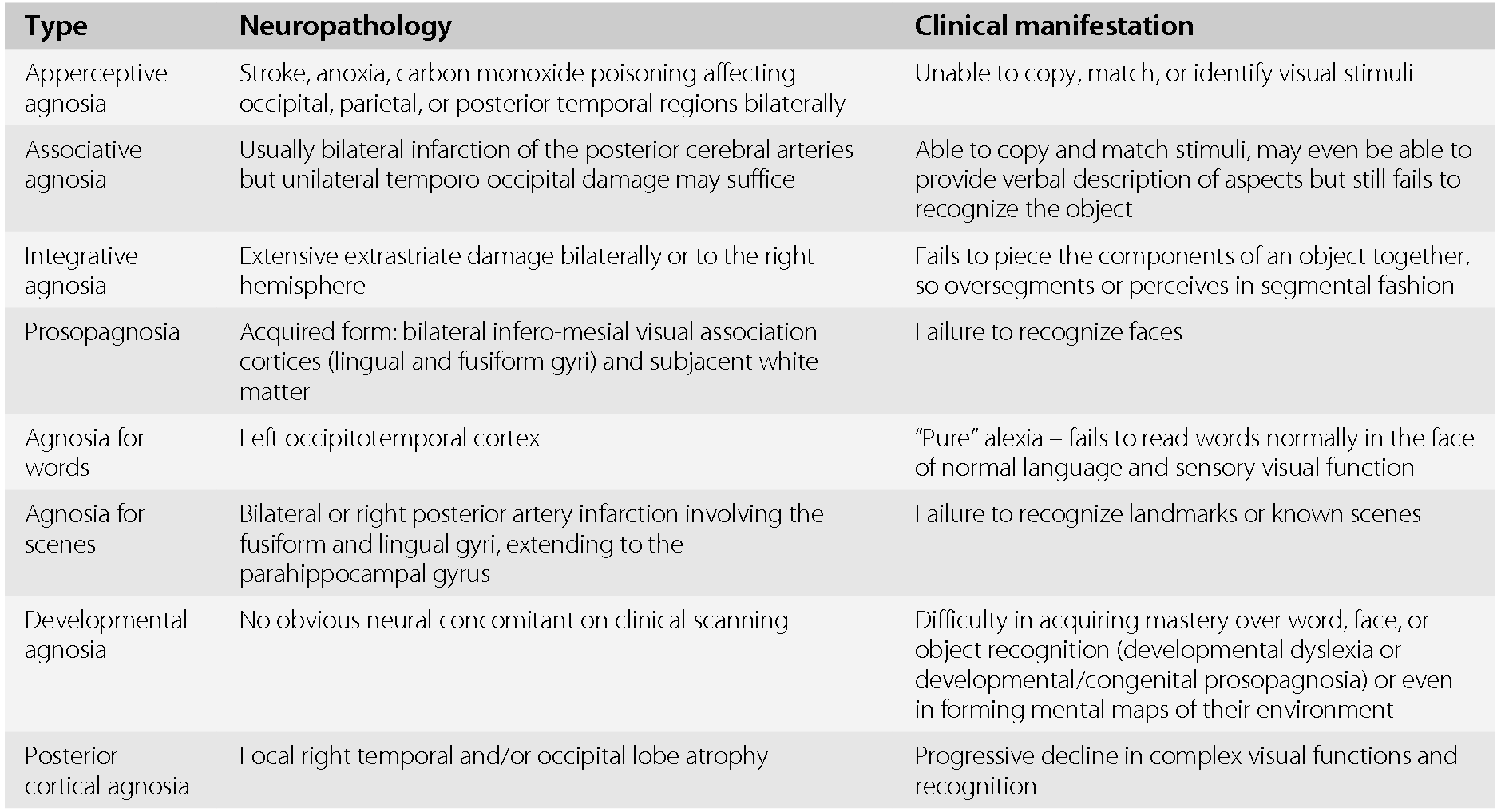
Agnosias (Chapter 3) - Neurologic Differential Diagnosis
Categories of Agnosia - AGNOSIA
Visual Agnosia - an overview | ScienceDirect Topics
Image result for visual agnosia | Words, Visual, Word search puzzle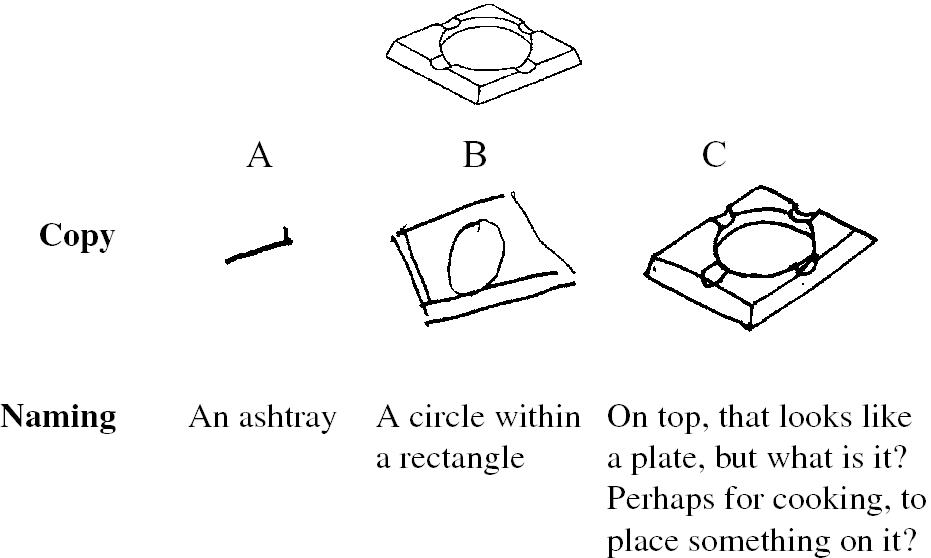
Object and color agnosia (Chapter 20) - The Behavioral and Cognitive Neurology of Stroke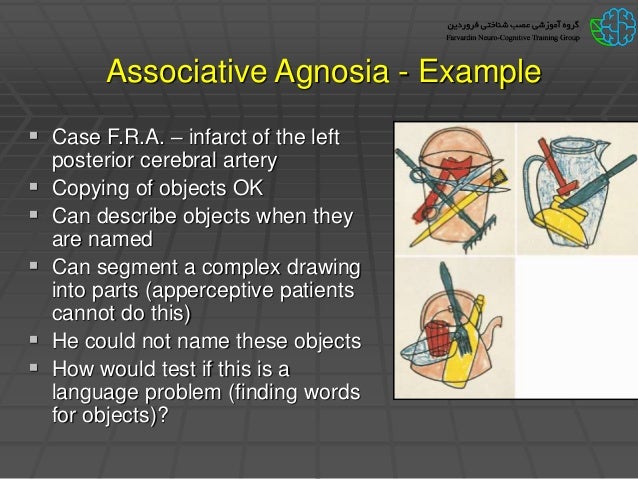
Vision and agnosias
Perception - Cognitive Processes - Lecture Slides - Docsity
Agnosia and prosopagnosia:
Deep Understanding of Agnosia – AGNOSIA
Associative visual agnosia - Wikipedia![Lovecraft / General] What would happen if a person with blindsight or visual agnosia were to look upon the eldritch? : AskScienceFiction Lovecraft / General] What would happen if a person with blindsight or visual agnosia were to look upon the eldritch? : AskScienceFiction](https://lh3.googleusercontent.com/blogger_img_proxy/AEn0k_uqiiCxomvnXWHm0d8YJ_I9rJ3pT9xu8RgLgMv0maEkqm7sqEdPVZrRED52kwXY07yN4ys36q-Vk_ZQvE3Bz1sPYQ=s0-d)
Lovecraft / General] What would happen if a person with blindsight or visual agnosia were to look upon the eldritch? : AskScienceFiction
Agnosia
Lecture 4- Agnosia and Prosopagnosia - StuDocu
Assessment - AGNOSIA![Lovecraft / General] What would happen if a person with blindsight or visual agnosia were to look upon the eldritch? : AskScienceFiction Lovecraft / General] What would happen if a person with blindsight or visual agnosia were to look upon the eldritch? : AskScienceFiction](https://lh3.googleusercontent.com/blogger_img_proxy/AEn0k_uNKmZSxrNI9knwONtMwya7SgpfXZMgm6A4LAI5uhYa2juYHQKLoOqPN1nRKwb1nvvKGBkwzVEIyHByopXUv6P4=s0-d)
Lovecraft / General] What would happen if a person with blindsight or visual agnosia were to look upon the eldritch? : AskScienceFiction
Perceptual deficits of object identification: apperceptive agnosia - ScienceDirect
Agnosias, apraxias, and callosal disconnection syndromes (Chapter 23) - Stroke Syndromes, 3ed
Lecture 3 Vision and Agnosias - ppt download
PDF) Associative Visual Agnosia: A Case Study
Apperceptive Agnosia disease: Malacards - Research Articles, Drugs, Genes, Clinical Trials
Occipital lobe 2 syndromes nwnw ppt
Visual System Flashcards | Quizlet
Chapter 6 Higher Perceptual Functions Second Edition Cognitive Neuroscience The Biology of The Mind by Michael S. Gazzaniga Ri
Apraxia, agnosias, and higher visual function abnormalities | Journal of Neurology, Neurosurgery & Psychiatry
PPT - Agnosia and Perceptual Disturbances March 17, 2008 PowerPoint Presentation - ID:3889055
High-Level Visual Processing: Cognitive Influences | Neupsy Key
Visual Agnosia and Optic Aphasia: Are They Anatomically Distinct?
PDF) Agnosias
Chapter 4 - CLPS 0200 - StuDocu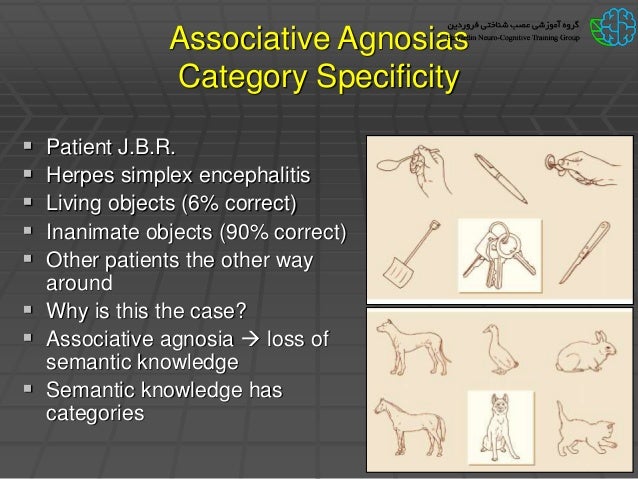
Vision and agnosias
Object Recognition -Segregation of function -Visual hierarchy -What and where (ventral and dorsal streams) -Single cell coding and ensemble coding -Distributed. - ppt download
Figure 21.2 from Chapter 21 Visual agnosia. | Semantic Scholar
Rehabilitation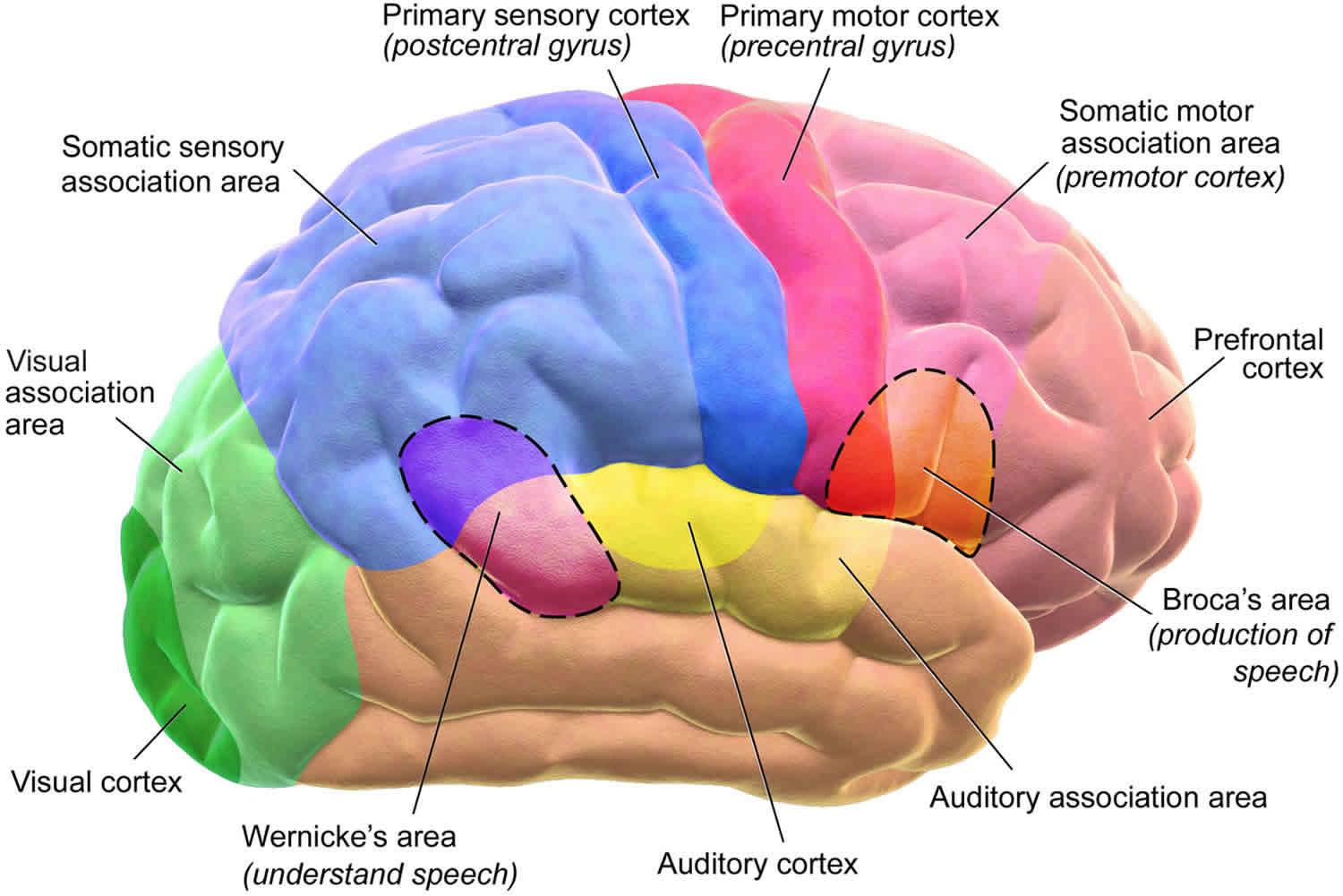
Agnosia definition, causes, types, symptoms, diagnosis & treatment
 Visual Agnosia - an overview | ScienceDirect Topics
Visual Agnosia - an overview | ScienceDirect Topics





























Posting Komentar untuk "apperceptive vs associative agnosia"